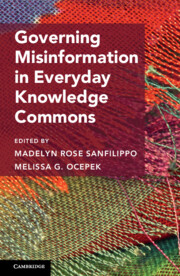Figures
1.2Ice cream advertisement on a barn in Plymouth, WI. ©Terry Williamson
2.1Visual themes from storytelling and/as misinformation: storytelling dynamics and narrative structures for three cases of COVID-19 viral misinformation
3.2Hypothetical growth of COVID-19 cases over fifteen days with a doubling time of three days, presented graphically
4.1Visual themes from information hazing: an examination through computer science education
5.1Visual themes from common nonsense about password security and the expert–layperson knowledge gap
6.1Visual themes from hacks, fakes, and hot takes: moderating “bad actors” on Google Maps Local Guides Platform
6.2A screenshot of Google Maps desktop with a focus on the UK-based department store Marks & Spencer
6.4Screenshots of Local Guides YouTube channel, with the video how to add a photo
6.5Google’s official points system (a) and Local Guides levels (b)
6.6Screenshot of Google’s guidance on how to report a review
7.1Visual themes from the human infrastructure of misinformation: a case study of Brazil’s heteromated labor
8.1Visual themes from hidden virality and the everyday burden of correcting WhatsApp mis- and disinformation
9.1Visual themes from “do your own research”: everyday misinformation and conspiracy in online information worlds
9.2Key to the Q-Web or deep state map mapping project (Monroe 2018)
9.3Great awakening map exposing and connecting all hidden global information (TyGunnard 2020)
10.1Visual themes from how to manage issues on Twitter: perspectives from Twitter users concerned about mis/dis-information
10.2Robust multiway ANOVA results: demographic differences in actions taken by participants
10.3Robust multiway ANOVA results: demographic differences in actors to take responsibility
11.1Visual themes from community governance of false, fabricated, omitted, and out of context claims on Instagram
11.4Sentiment distributions by action arena, weighted by number of posts

